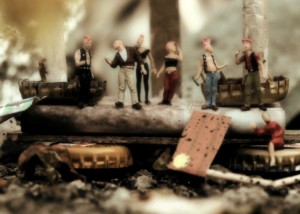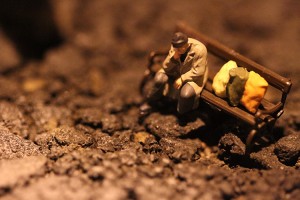Why is it Always Four in the Morning?
If Aliens were to float around examining our culture for a while, they may well decide that four in the morning has a special significance in our culture. It might take them longer to figure out why.
 Which is what American performance poet, storyteller and author, John G. Rives discovered after reading a poem which he couldn’t get out of his head.
Which is what American performance poet, storyteller and author, John G. Rives discovered after reading a poem which he couldn’t get out of his head.
Most of us have had that experience but this one was so convincing that what began as a minor obsession ended up as the creation of the Museum of Four in the Morning…
If you doubt the significance, watch the TED Talk presentation.
If you know why this phenomenon exists, please post your wisdom on the forums.
In an earlier appearance at TED Talks, Rives performed one of his poems, sharing what it would be like…
If I Controlled the Internet
If I controlled the internet
You could auction your broken heart
on Ebay…
Presentations by Rives at TED include
- “If I controlled the Internet”
- “A mockingbird remix of TED2006”
- “The 4 a.m. mystery”
- “A story of mixed emoticons”
- “Reinventing the encyclopedia game”
- “The Museum of Four in the Morning”
Monty Python Reunite
With a constant deluge of bad news stories, one area that brings more than its share of good news stories is the arts and this week brought the particularly good piece of news that the British surrealist comedy group, Monty Python are reuniting to perform, after a 30 year break. At the news conference today they say the fact that the original humour still goes down so well after 40 years is “astounding and genuinely surprising”
The sixth member of the group, Graham Chapman died in 1989. “We’ll miss Graham quite a lot” says Idle, “but he will be there. We have told him we’re going to be on, and if there is a God then he’ll show up”. In typical Pythonesque style, the backdrop at today’s press conference reads: “One down, five to go”.
They joke that they will advertise tickets to their show as “£300 cheaper than the Rolling Stones” with tickets starting at £27.50 and go up to £95. Cleese said they would almost certainly include popular sketches such as the Crunch Frog and the Dead Parrot, but there will also be new material that has never been performed live.
The show will take place at London’s 02 Arena on 1st July 2014. Tickets go on sale on 25 November.
The comedy sketch show Monty Python’s Flying Circus started in 1969 and 45 episodes were aired over four series. Their humour expanded into radio, books , music and films and their influence on comedy has been compared to the influence of The Beatles on music. Monty Python’s Flying Circus was made all the more memorable by Terry Gilliam’s quirky artwork. Gilliam started his career as an animator and strip cartoonist.
Because Monty Python were completely self-contained with the members Graham Chapman, John Cleese, Terry Gilliam, Eric Idle, Terry Jones, and Michael Palin both writing and performing their own work, they were able to experiment beyond the rules of television comedy.
The well known song from “The Life of Brian” “Always Look on the Bright Side of Life” was performed by Eric Idle at the 2012 Olympics closing ceremony.
http://www.montypythonlive.com/
All six Python members appeared in and/or wrote the following shows before Flying Circus. The Frost Report is credited as first uniting the British Pythons and providing an environment in which they could develop their particular styles:
• I’m Sorry, I’ll Read That Again (radio) (1964–1973) [Cleese: cast member & writer] – [Idle and Chapman: writers]
• The Frost Report (1966–1967) [Cleese: cast member and writer] – [Idle: writer of Frost’s monologues] – [Chapman, Palin and Jones: writers] • At Last the 1948 Show (1967) [Chapman and Cleese: writers and cast members] – [Idle: writer]
• Twice a Fortnight (1967) [Palin and Jones: cast members and writers] • Do Not Adjust Your Set (1967–1969) [Idle, Jones, and Palin: cast members & writers] – [Gilliam: animation] — Bonzo Dog Band: musical interludes]
• We Have Ways of Making You Laugh (1968) [Idle: cast member & writer] – [Gilliam: animation]
• How to Irritate People (1968) [Cleese and Chapman: cast members & writers] – [Palin: cast member]
• The Complete and Utter History of Britain (1969) [Palin and Jones: cast members & writers]
• Doctor in the House (1969) [Cleese & Chapman: writers]
Read MoreTed Chung: A Thousand Words
Ted Chung is a talented film director who grew up in the Chicago suburbs and went on to UCLA Film School, where he received the UCLA Directors Spotlight Award.
Chung demonstrates what excellent directing can achieve in a short film of less than five minutes. Simply using the camera, well integrated music, very well chosen actors and a fine understanding of visual communication, timing and nuances he is able to convey the character, feelings and emotions of the protagonists without the use of a single spoken word.
“A Thousand Words” and his film “Mike” are both shot very effectively in black and white. He elaborates:
” B&W is an immediate way of creating a style – especially when you’re shooting without many resources and can’t control the color scheme as much as you’d like. After shooting Mike’s and A Thousand Words in B&W, it was great being able to do On Time where everything was built or carefully sourced to align with an established color palette”
In an interview he explains the importance of music in his work:
“Music has a direct line to the subconscious, to emotion. Even a baby who doesn’t fully understand language yet can be emotionally influenced by a piece of music. It’s a very powerful tool in conveying feelings and ideas, but I think it’s important to have some restraint in how you deploy music. It’s often stronger to be more suggestive and give the audience space to fill with their own feelings. “
He was also selected for the Berlinale Talent Campus, where he directed On Time, a magical realism tale that premiered at the 58th Berlin Film Festival.
He is currently at work on his newest film, the sci-fi thriller I D.
“Ted Chung is one of my top five filmmakers on the web because he understands how to tell stories with or without words. The picture quality is irrelevant to his work. He uses screen direction and movement only when it is necessary to tell his story. He shows emotion and feeling in his characters, in his direction, and in the wonderful actors he casts. Most of the situations in his previous film involved lost chances and that’s some thing we all can intensely relate to. It is the moment that you are afraid, but you find the courage to take either the chance or not. Ted understands storytelling and that makes him a real filmmaker- Hollywood style,” says Director Steve Weiss.
Also directed by Ted Chung: “On Time“: http://vimeo.com/12947399
“Mike’s”: http://vimeo.com/16509726
tribecafilm.com/news-features/super_shorts/Super_Shorts_A_Thousand_Words.html
zacuto.blogspot.com/2009/12/steves-top-picks-for-2009.html
vimeo.com/album/159627/page:2 berlinale-talentcampus.de/campus/talent/ted-chung zacuto.com/featured-filmmaker-ted-chung
“An elegant and very affecting portrait of big-city loneliness and the instant connections that go “ping” and are gone seconds later. The emotions are halting, delicate, true.” -Jeffrey Wells, Hollywood Elsewhere
Read MoreSculptor Anthony Caro
Sir Anthony Caro, one of Britain’s top sculptors and a pioneer of modernist art died of a heart attack on Thursday (October 24th 2013).
Caro is widely regarded as the greatest British sculptor of his generation and played a major role in the development of 20th Century sculpture.
He worked as an assistant to Henry Moore in the 1950s and first came to public attention with a show at the Whitechapel Gallery in 1963 in which he exhibited large abstract sculptures which stood directly on the ground (rather than on the tradition sculptural plinths) and were brightly painted, encouraging direct interaction with the viewer.
Above: Artist Sir Anthony Caro in conversation with Julius Bryant,
Keeper of Word & Image, Victoria and Albert Museum, London.
From the BBC in Pictures: Anthony Caro
more information on their website
Picture 1 : Sculptor Sir Antony Caro, who has died at the age of 89, first came to public attention with his large abstract sculptures in the 1960s. Widely regarded as one of Britain’s greatest sculptors, his work has continued to be displayed and enjoyed around the world.
Picture 2 : The sculptor’s Month Of May (1963) – made from steel and aluminium – was on display as part of The New Situation: Art in London in the Sixties exhibition at Sotheby’s auction rooms in September.
Picture 3 : An exhibition of monumental sculptures by Sir Anthony opened at Chatsworth House in Derbyshire in 2012. The show featured steel works arranged around the Canal Pond, facing the Duke of Devonshire’s historic home.
Picture 4 : A room was given over to Sir Anthony’s steel structure Shadows when it featured in the Royal Academy’s Summer Exhibition in June.
Picture 5 : His sculpture Millbank Steps 2004 has been displayed at Tate Britain. Made from 100 tonnes of steel, it is 5 metres tall and 25 metres across.
Picture 6 : The design team behind London’s Millennium Bridge comprised of Tony Fitzpatrick, Lord Foster and sculptor Sir Anthony. The bridge wobbled when it opened in June 2000 because of what engineers called “synchronised footfall” and had to be shut down to be fixed and reopened in February 2002.
Picture 7 : A sculpture titled Blazon by Sir Anthony was one of of five of his large-scale sculptures installed on the Metropolitan Museum of Art’s Roof Garden in 2011.
Picture 8 : The sculptor designed the gold Olympic UK Kilo coin for the Royal Mint, which was unveiled at the Royal Academy in 2011.
Read MoreSeed Story
 As a lone dandelion blossoms in an abandoned parking lot, it divides the lives of several miniature people in this experimental narrative short film by award winning film maker William D. Caballero.
As a lone dandelion blossoms in an abandoned parking lot, it divides the lives of several miniature people in this experimental narrative short film by award winning film maker William D. Caballero.
Filmed in an abandoned parking lot, using a cast of carefully painted tiny model figures this experimental film focuses on the destructive addictions humanity has suffered through the ages.
The film looks at the role of religion, capitalism, environmentalism and fascism through the perspective of macro photography.
Shooting took place over two months in the Summer of 2012, on a budget of less than$3,000. Torches, sparklers and smoke guns were used to create special effects.
Shooting was done close to the ground, during both days of 90 degree heat and heavy rainstorms. The biggest disruption proved to be breezes that at times blew entire sets away.
 Directed and conceived by William D. Caballero, it premiered at the 2013 Slamdance Film Festival and at numerous festivals across the world.
Directed and conceived by William D. Caballero, it premiered at the 2013 Slamdance Film Festival and at numerous festivals across the world.
As of April, 2013, SEED STORY has screened or will screen at numerous film festivals, including a world premiere at the SLAMDANCE FILM FESTIVAL in January, 2013. The festival had a less than 2% acceptance rate making entry into it more competitive than entry into Harvard!
AWARDS:
VANGUARD AWARD (for directors who are pushing the boundaries of experimental/non-linear film) at the 2013 ART OF BROOKLYN FILM FESTIVAL!
BEST SOUND DESIGN at the 2013 VISIONFEST
BEST SHORT FILM (Honorable Mention) at the 2013 PHILADELPHIA INDEPENDENT FILM FESTIVAL
OFFICIAL SELECTIONS
- VIMEO STAFF PICK
- SLAMDANCE FILM FESTIVAL
- ATLANTA FILM FESTIVAL
- RxSM FILM EXPO
- PHILADELPHIA INDEPENDENT FILM FESTIVAL
- VISIONFEST
- KAHBANG FILM FESTIVAL
- ART OF BROOKLYN FILM FESTIVAL
- VICTORIA TEXAS INDEPENDENT FILM FESTIVAL
- XICAN INDIE FILM FESTIVAL
- INDIANAPOLIS INTERNATIONAL FILM FESTIVAL
- GUANAJUATO INTERNATIONAL FILM FESTIVAL
- PORTLAND UNDERGROUND FILM FESTIVAL
- HARLEM INTERNATIONAL FILM FESTIVAL
More to come!
To see a new short film consisting of deleted scenes from Seed Story, click here: vimeo.com/74943004
The film below was created using deleted scenes from the Seed Story film.
For more information on the project, visit wilcab.com/seedstory/
Directed, produced, shot, edited, animated, and scored by William D. Caballero
“Special thanks to the art crew and production team. I couldn’t have done it without you.”



